Want to Build an MVP App?
We’re at your service with 10-year expertise. Just fill in the form and we’ll send an estimate.
Do you know that 9 out of 10 startups fail during the first year after launch?
It happens for multiple reasons like lack of product-market fit, wrong marketing activities, financial problems, etc.
But are there any ways to mitigate risks before launch? Yes, building a minimum viable product is one of the keys to your success.
In this post, you will learn how to build an MVP app along with:
MVP in software means building a limited version of your digital product including the minimum features that provide value to customers. They should just be enough to showcase your startup idea and collect end-users’ feedback. Top MVP examples include Airbnb, Amazon, Buffer, and others.
Depending on the results you receive after launching an MVP, you can deliberately conclude whether it is worth investing further and developing a full-featured product or taking your time for business idea improvement.
The image below should help you better understand what is MVP in software development.
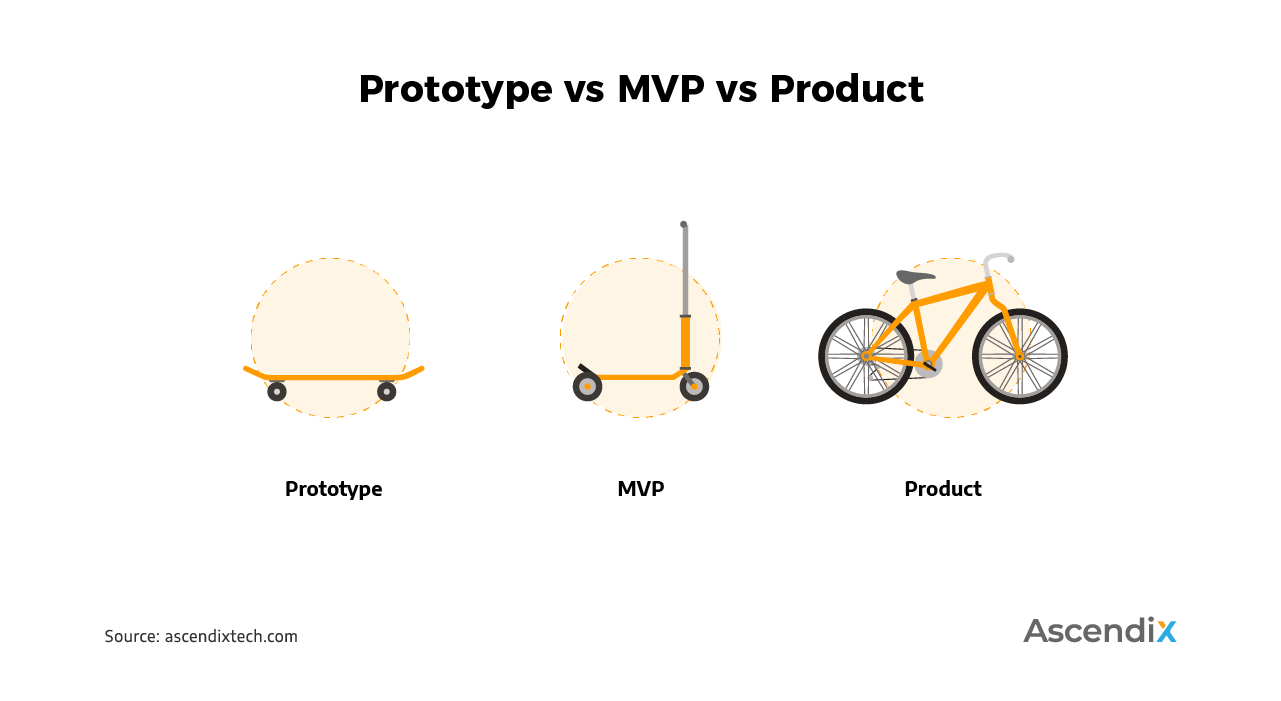
Prototype vs MVP vs Product
In order to strengthen your understanding of an MVP concept, let’s take a look at the story of Buffer.
Buffer is a web-based SaaS startup that allows you to schedule social media posts and avoid the newsfeeds of friends by spacing out your updates.
In 2010, Joel Gascoigne, the founder of Buffer, was developing his startup and didn’t want to bump into a low product-market fit.
So, Joel decided to validate the product idea by creating a minimum viable product – an intuitive landing page with a short product description, pricing plans, and sign-up form.
However, users massively started signing up to test the product, but they were shown a message that Buffer wasn’t ready to launch.
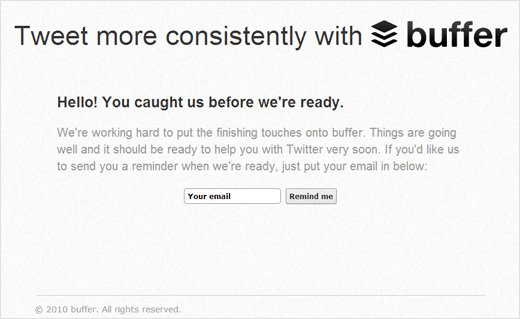
To keep leads interested, Joel started an email campaign and conversations with end-users to get their feedback on what features did they want to have.
The next step of Joel was to test the hypothesis and identify the potential conversion rate. The product team decided to make the pricing plans available only by clicking on the button.
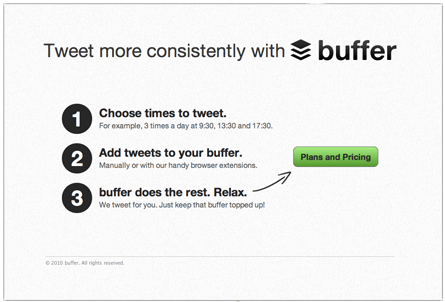
This way, Joel has understood how many end-users would have potentially become real customers.
The product team mitigated any risks and doubts to start building the first full-featured web-based application with a high product-market fit beforehand.
Below you can see detailed screens of the initial Buffer landing page blocks launched in 2010.
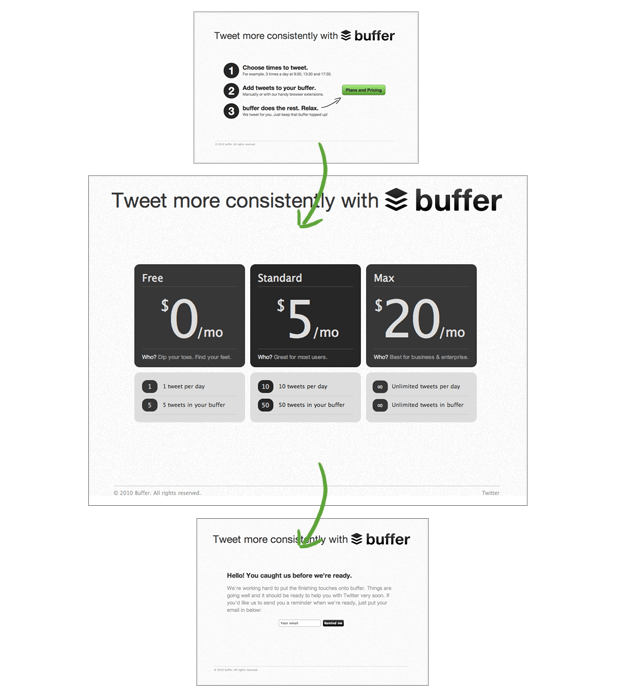
Let’s now overview the key advantages that a minimum viable product concept can bring to your startup/product.
As we mentioned earlier, many startups fail after launch as their product doesn’t solve the direct needs and problems of end-users. The key mistake here is trying to identify whether your solution has its place in the market AFTER LAUNCH.
Here comes the approach of building a minimum viable product that allows you to create a solution with enough features that provide real value to customers. This way, you can save much time, funds, and validate your product idea before launch by gathering valuable feedback from early users.
The collected comments, notes, and preferences of end-users allow you to answer the core questions:
So, building an MVP is a great way to deliberately analyze whether your startup product idea really makes sense to your target audience and is worth improving on.
Customers become more and more demanding daily due to a rising number of value propositions on the market. It means that end-users analyze multiple similar products and highlight even the micro benefits they can get to make the final decision.
This way, a short time-to-market period is crucial for startups to become the #1 product for customers. The more you wait, the better your competitors become. So, launching an MVP is a great opportunity to roll out the limited version of your product to the market, gain feedback, and grow your solution further.
There is no need to invest much time and funds into building a full-featured product that takes 6-12 months. Instead, build an MVP, present it to early users, and move on.
According to the Forbes article, most investors give priority to the products supported by market interest. No matter how technically great your solution is, the chances of pitching your product to investors become higher when you have numbers to showcase.
Startup MVP development can help you accelerate and boost the quality of communication with investors. If you build a product with enough features to be valuable for customers, you then collect market insights represented by numbers.
This way, potential investors can overview the real value of your product idea in the eyes of early users, and your startup gains a higher priority for stakeholders.
As we stated above, creating a minimum viable product is a common practice even for the world’s largest products. The matter is that they used to be startups many years ago and had similar goals like cost optimization, idea validation, and acquisition of investors.
Now we want to share some of the most successful MVPs from world-known products.
One of the largest American e-commerce websites selling vintage and handmade items with $1,7 billion annual revenue in 2020, Etsy was founded in 2005 by Rob Kalin. Initially, the idea of building a huge marketplace came to his mind when he faced the challenge of selling wooden-cased computers.
At that time, Rob tried Amazon, but he experienced high seller fees and user-flow difficulties. So, he came up with the idea of building an e-commerce website for his business.
Over time, Kalin launched an MVP website with a simple UI/UX design and plain functionality that just allowed users to sign up and list their handmade products. In as little as one night, thousands of sellers joined Etsy’s first website and started selling their items.
This smart and simple approach allowed Rob to validate his product idea instantly and cost-effectively even before using the revenue to improve and scale on.
Here is the first Etsy’s website design back in 2005.
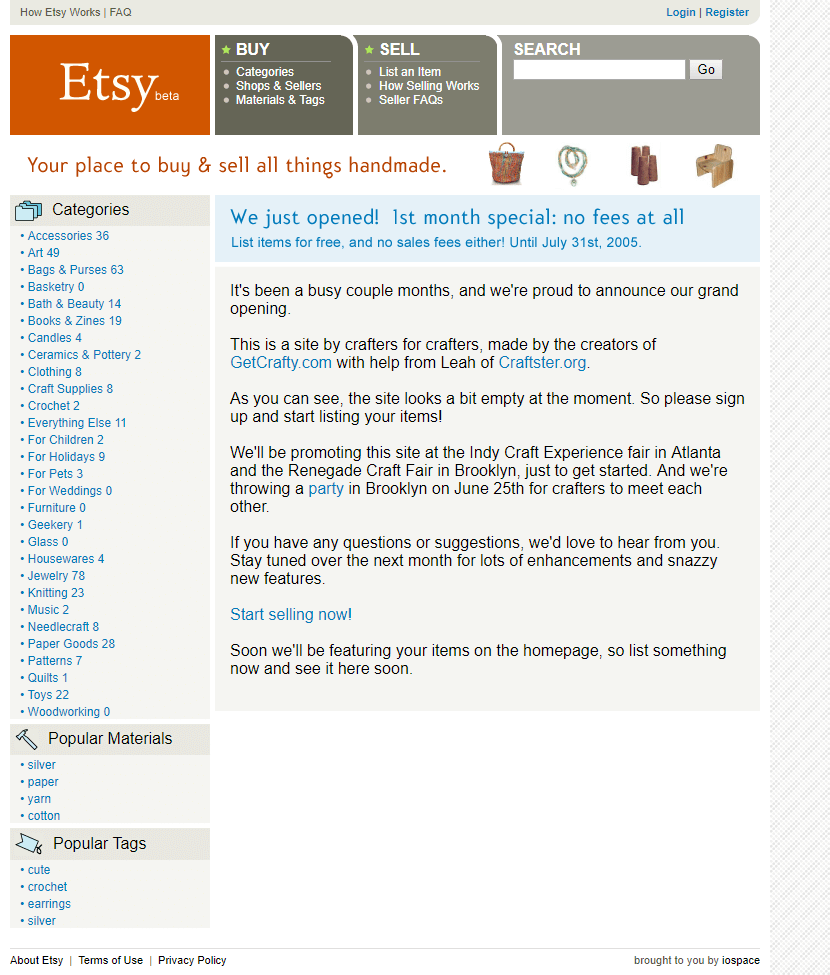
The first MVP website of Etsy in 2005
One of the largest online marketplaces for lodging, vacation rentals, and tourism activities with over 7.7 million active listings in 2021, Airbnb was started back in 2007.
Joe Gebbia and Brian Chesky, a couple of designers facing overbooking issues during the IDSA, decided to make some money and built a simple-to-use website for advertising their house room for the weekend.
Being unsuspicious of the upcoming success, designers got three requests to rent their room overnight. This situation spurred them to create a full-featured marketplace and connect travelers around the world helping them to rent/lodge accommodation.
Below you can see the first-ever design of the Airbendandbreakfast (now called Airbnb) website during the IDSA ‘07.
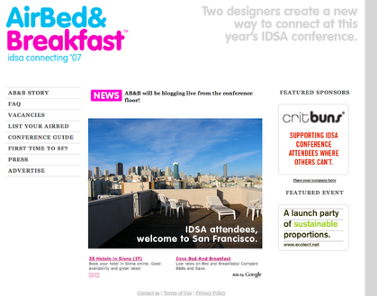
First MVP website of Airbnb in 2007
After that, Gebbia and Chesky began seeking financial aid and pitching their product to investors. Over time, their idea became one of the world’s biggest accommodation rental marketplace.
We’re at your service with 10-year expertise. Just fill in the form and we’ll send an estimate.
We have discussed what is MVP in software development along with the experience of well-known global companies in developing an MVP.
Now you’ll learn the key minimum viable product stages that will help you understand how to develop an MVP.
According to the CB Insights Report, 42% of startups fail due to the lack of market need. This means that almost half of startups do not solve the real problems of customers to gain enough traction and survive.
For this reason, it’s crucial to initially define the core challenge your startup product will solve for end-users. There are several ways to find your product’s key value proposition:
You definitely use multiple mobile apps, websites, tools, and other products daily, allowing you to analyze each of them and think of how you would have improved them.
Do they cover all your needs and solve even micro-challenges you experience? Have you ever wanted to improve some features for advanced usage?
These questions should pay attention to the details that may become a part of your product value proposition.
As personal experience seems to be quite subjective, you can ask relatives, friends, and other close ones whether they have some ideas or problems that are vital for them currently. When you collect their feedback, you can ask yourself whether you can build such a product.
Millions of people use Facebook, Twitter, Reddit, LinkedIn, and other platforms every day which means that you can find their ideas, thoughts, complaints, and problems.
Once found, you can analyze whether these problems are major to a wider audience. For example, use relevant subreddits, Quora threads, and other AMA platforms where users will give answers to your question.
Product reviews of similar software can help you a lot. Reading the pros and cons of products will give you an idea about features that users like and what functionality they miss. You may want to check review websites like G2Crowd, Capterra, Softwareadvice.
Product Hunt is another great place to be as you can see what type of products people love and are ready to support.
I also recommend following AppSumo deals. This company offers lifetime deals for software companies, and many startups use them to gain first-paying customers.
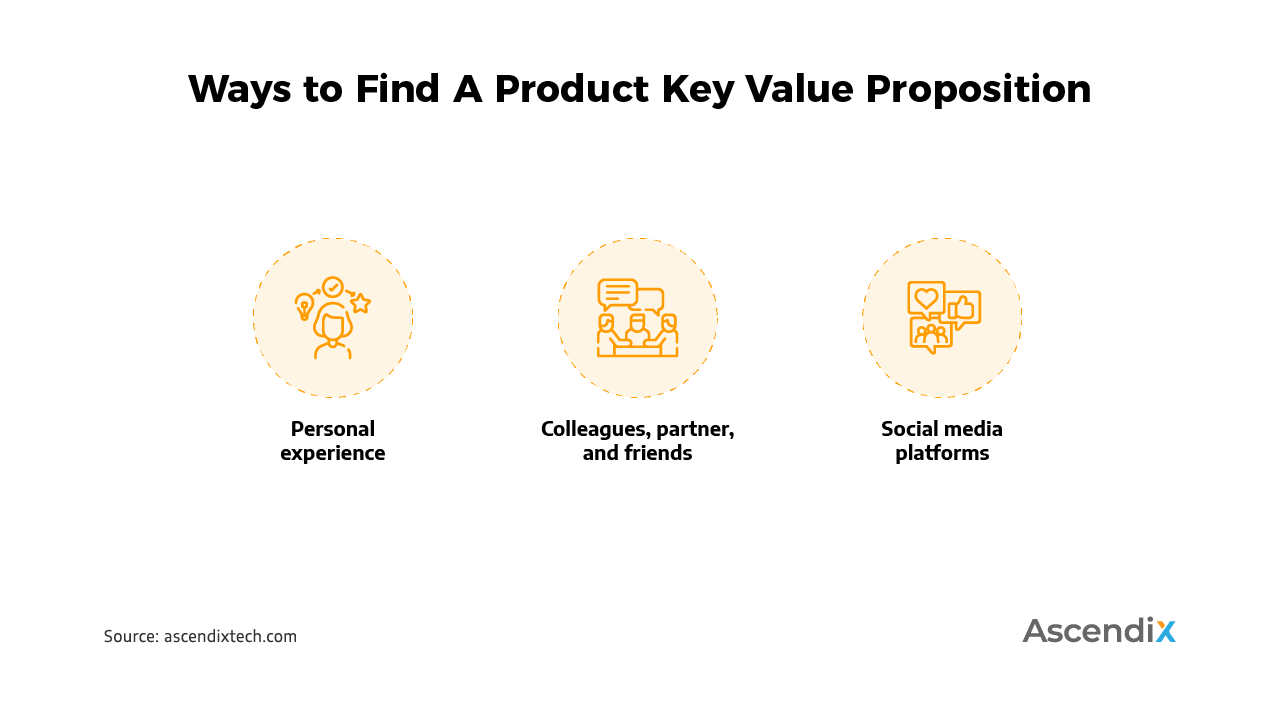
3 Ways to Find A Product Key Value Proposition
Once you have identified the problem to solve, you should do market research. It is a complex of activities related to analyzing competitors and the product-market fit.
Why should you take care of your market rivals at this stage?
It may seem unobvious, but dozens of startups launch their products daily and many of them can be pretty similar to your solution. So, it’s super effective to analyze them and identify the growing points that will help you stand out from the competition.
Take a close look at their unique features and try to find their blind spots. These will become opportunities that will help you boost your product idea and provide a more valuable solution that will better meet customers’ direct needs.
One of the great techniques used in analyzing your competitors is the SWOT analysis. It is a strategic planning tactic that allows you to define the Strengths, Weaknesses, Opportunities, and Threats of your product and helps you to become prepared for business competition.
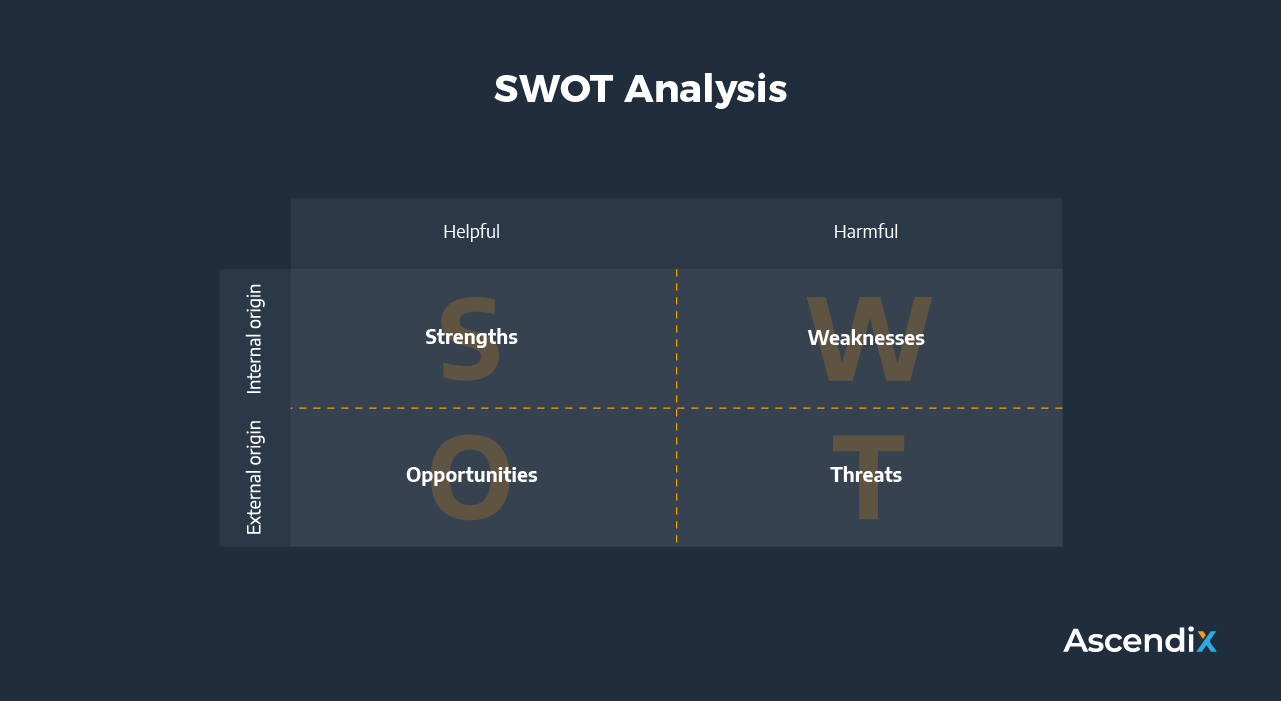
SWOT Analysis
Another important aspect of market analysis is to find your target audience and define the key segments.
A target audience is a group of people who have similar interests, challenges, pains, requests, dreams, geographical, and social parameters. These should be the users with the biggest desire to gain a solution you will provide.
Segmentation means that you divide your target audience into smaller groups of users with similar interests to provide a more detailed and personalized advertising message. It will better meet their internal needs and challenges than just offering a single wide value to the whole target audience.
Here’s a great tutorial on doing audience research and getting into your customer’s head using Facebook Audience Insights Tool.
Also, market analysis can help you define the market demand for your startup product. You can set up focus groups and interview users on social media to collect their feedback and predict whether potential customers will need your product.
MVP app development is about building a limited version of your product with enough features providing the core value proposition to end-users. It means that you need to choose one or several must-have features most valuable for your target audience.
First, we recommend analyzing your startup product’s user flow which stands for the key steps your customers will take to make the desired action.
For example, let’s take a look at the Amazon user flow for buyers. So, they need to:
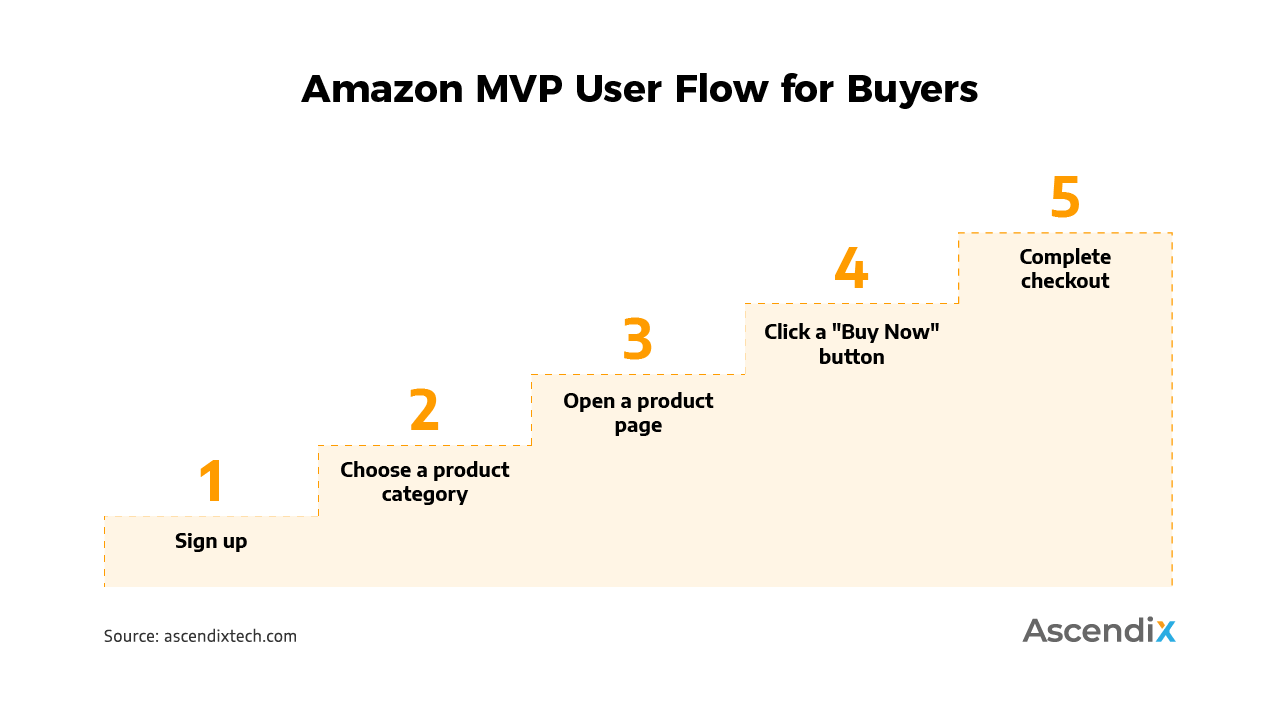
Amazon MVP User Flow for Buyers
For sure, we mentioned only the basic must-have functionality that should have been implemented to allow buyers to purchase the desired product.
So, analyze your solution, identify the core value, and build the user flow required to make the desired action and achieve this value. This way, you will understand what functionality is essential for building a minimum viable product with end-users in mind.
Well, you have conducted market research and chosen the must-have features that provide a core value proposition to your end-users. What’s next?
Now it’s high time to validate your startup product idea by creating a demo version of your solution.
There are three options building a wireframe, mockup, or prototype. They differ by a measure of similarity to the final product.
What is a wireframe?
Simply put, a wireframe is a two-dimensional skeleton of your solution that demonstrates the basic page structure, layout, data architecture, user flow, and functionality overview.
What is a mockup?
In turn, a mockup is a static and more realistic representation of your product than a wireframe. Mockups are about high-fidelity design diagrams that are not clickable nor interactive.
What is a prototype?
A prototype is a very close interactive and clickable representation of your final product which even simulates the user flow of potential customers. It allows you to save a lot of time and development costs along with collecting valuable feedback from your target audience.
The comparison scheme below should help you better understand the wireframe vs mockup vs prototype difference.
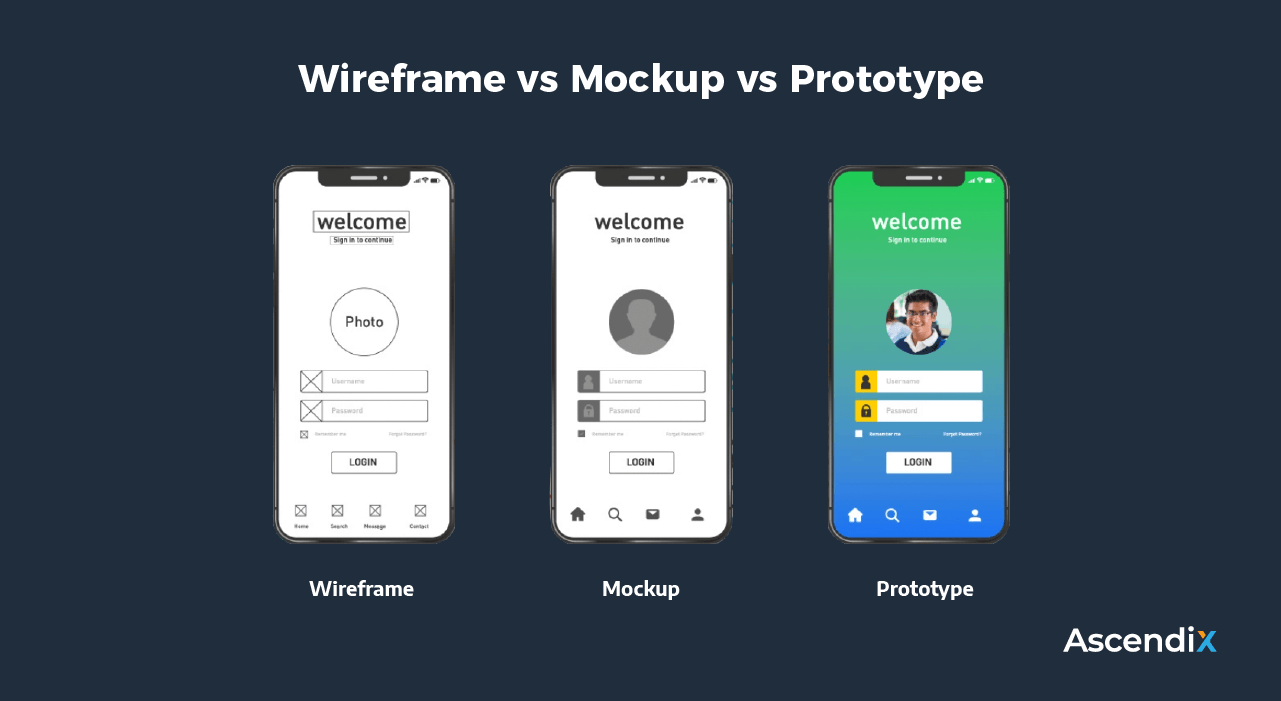
Wireframe vs Mockup vs Prototype
Let’s assume you decide to test your product idea by building a prototype as it’s the closest copy of your future final solution. Here comes the question: how to create an MVP prototype?
First, you can take a pen and a piece of paper to start visualizing your thoughts, and nobody knows your startup product better than you do. At this stage, we also recommended you think about making a mobile app RFP, where you can outline specific goals and needs of your app.
Begin prototyping with a core user flow that your customers will find the most convenient way to do the desired action. Step by step, you will create several prototypes of the most crucial scenarios and functions.
Second, you can leverage UX prototyping software which greatly saves time and provides multiple ready-made templates out-of-the-box.
What’s more, you can find well-known market competitors’ templates and use them as a basis to accelerate the process of creating a prototype and improve it with your unique features.
Here are the leading prototyping software solutions:
We recommend paying attention to Figma and Marvelapp tools as they provide free plans that can meet your prototyping needs.
Here’s a great how-to manual from Join Rogie, a designer advocate at Figma, where he shares the prototyping process in Figma by creating a design and demos for a book app.
Once you’ve built an MVP prototype, share it with your target audience on social media and stakeholders. Collect their feedback, identify pain points, and analyze the product insights.
What’s more, prototyping is an important aspect of the startup MVP development process which allows you to drive user engagement even before the launch of your startup.
This will help you reduce marketing costs and choose the most effective promotion strategy based on the platform’s most target feedback for your solution.
As a technology advisor, we partner with small firms and global enterprises helping them bring automation to their operational processes.
After validating your product idea with an MVP prototype, you can move to developing an MVP. This is about creating the must-have functionality you have already chosen along with the defined UX/UI design.
There are four options for building a minimum viable product and the choice depends on your technical background, financial aid, and time available for execution.
The key benefits of partnering with a technical professional are background, dedication, and responsibility.
First, the Chief Technical Officer should have a solid background in coding, managing IT teams, and creating product architecture. This person has a clear technical and business vision of startup product development as he/she will be responsible for meeting business objectives through technical implementation.
Second, finding an experienced technical partner can lead to acquiring a highly self-dedicated professional willing to build MVP products with killing features for potential customers.
ΩThere are good chances that this person will work as hard as you personally do to achieve business objectives and make your startup successful.
Third, a CTO will take all the technical responsibilities for MVP product development, focusing on marketing, fundraising, and other aspects while keeping a professional consultant around the corner.
This person clearly knows how to create a minimum viable product app and make it successful by reaching business objectives through technical implementation.
The key methods to find a great technical co-founder are:
Here is a valuable video from Michael Seibel, the CEO and Managing Partner at YCombinator, sharing his thoughts on how to find a technical partner for launching an MVP.
Ultimately, a CTO will help you build an in-house software team that will concentrate on minimum viable product development and further improvement and support.
This option may become the most cost-effective but rather time-consuming. There are hundreds of thousands of engineers and development teams that provide freelance MVP software development services at both low and high rates and final quality.
If you decide to partner with a great remote team, we recommend visiting Upwork, Outsourcely, Fiverr, Freelancer, etc. These platforms list freelance engineers covering their portfolio, development rates, client reviews, and internal ratings that demonstrate their work quality.
This choice may become the most beneficial for your startup due to the technical background that seems quite relevant for your current needs. It means that these companies have solid experience in building a minimum viable product for specific verticals that may include your niche as well.
So, you can check the portfolio of each company where they share experience in providing MVP development services for startups and see how exactly they solved particular challenges and what results were driven.
What’s more, an MVP development company can provide consulting services to help you sharpen your startup product by improving the user flow and functionality depending on your needs and financial requirements.
The leading platforms to find these companies are Clutch, GoodFirms, G2, AppFutura, TopDevelopers, CrunchBase, etc. These are review and rating websites that list the most world-known MVP development companies providing their general information, case studies, client reviews, and internal ratings.
Hire Ascendix and we’ll execute your vision and create a thriving software product or bootstrap your existing solution.
This option is the most cost-effective yet pretty time-consuming. In case you have a solid technical background and enough skills, you can start developing an MVP yourself.
The key benefits of this option are cost optimization and quality. As nobody understands your product better, you can develop basic functionality and have a robust picture of how your solution should work.
This will greatly help you to find the right technical specialists that have a similar understanding of what your product is about.
What’s After MVP?
After completing the startup MVP development stage, you should make your minimum product alive and collect users’ feedback. ProductHunt, IndieHackers, and Reddit are among the top online platforms.
They aggregate entrepreneurs, startup founders, technical experts, and other users who may provide valuable feedback or become your customers.
What’s more, launch your marketing campaign through social media channels like Facebook, LinkedIn, Twitter, and others. Dozens of millions of active users make these sites a great place to boost product brand awareness, user engagement, and even a conversion rate.
Once you have collected feedback from your target audience, measure all users’ opinions, comments, notes, and even criticism to improve your product and build a full-featured killer app that will offer a better value proposition to customers.
We hope our detailed guide on building a minimum viable product will help you launch your startup in a time- and cost-effective way.
The key to success is testing, building, measuring, and learning. So, take our tips and implement them smartly within your startup product.
If you are looking for an MVP development company, we will be glad to facilitate your startup product and help with MVP application development within any engagement model you prefer. So, check our case studies or just drop us a line to discuss your business idea.
We would be glad to know how do you develop an MVP and what patterns did you use to succeed with your startup product. Please share your thoughts and experience in the comments below.
Daniil specializes in content marketing and has a deep knowledge of promoting the company's products and services through high-quality content. On the Ascendix blog, Daniil shares his tricks and tips on custom software development, provides technology trends and insights, and helps you get valuable content to make your business even more successful and profitable.
Get our fresh posts and news about Ascendix Tech right to your inbox.